CV_HelenKim
Mathematical models for local nontexture inpaintings
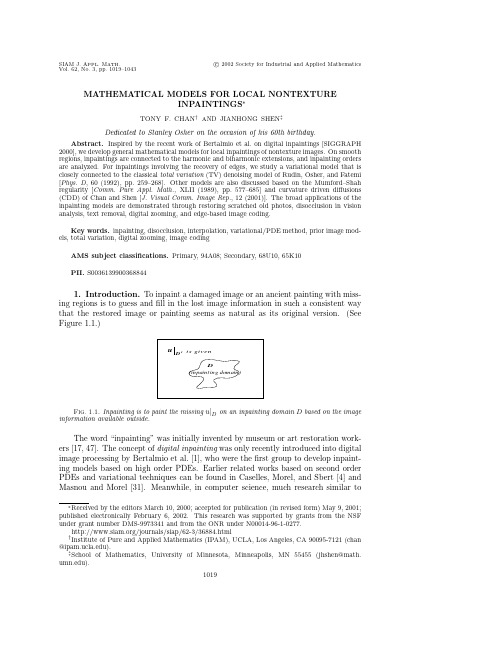
MATHEMATICAL MODELS FOR LOCAL NONTEXTURE INPAINTINGS ∗TONY F.CHAN †AND JIANHONG SHEN ‡SIAM J.A PPL.M ATH .c2002Society for Industrial and Applied Mathematics Vol.62,No.3,pp.1019–1043Dedicated to Stanley Osher on the occasion of his 60th birthday.Abstract.Inspired by the recent work of Bertalmio et al.on digital inpaintings [SIGGRAPH 2000],we develop general mathematical models for local inpaintings of nontexture images.On smooth regions,inpaintings are connected to the harmonic and biharmonic extensions,and inpainting orders are analyzed.For inpaintings involving the recovery of edges,we study a variational model that is closely connected to the classical total variation (TV)denoising model of Rudin,Osher,and Fatemi [Phys.D ,60(1992),pp.259–268].Other models are also discussed based on the Mumford–Shah regularity [Comm.Pure Appl.Math.,XLII (1989),pp.577–685]and curvature driven diffusions (CDD)of Chan and Shen [J.Visual Comm.Image Rep.,12(2001)].The broad applications of the inpainting models are demonstrated through restoring scratched old photos,disocclusion in vision analysis,text removal,digital zooming,and edge-based image coding.Key words.inpainting,disocclusion,interpolation,variational/PDE method,prior image mod-els,total variation,digital zooming,image codingAMS subject classifications.Primary,94A08;Secondary,68U10,65K10PII.S00361399003688441.Introduction.To inpaint a damaged image or an ancient painting with miss-ing regions is to guess and fill in the lost image information in such a consistent way that the restored image or painting seems as natural as its original version.(See Figure 1.1.)Du D cis given(inpainting domain)Fig.1.1.Inpainting is to paint the missing u D on an inpainting domain D based on the image information available outside.The word “inpainting”was initially invented by museum or art restoration work-ers [17,47].The concept of digital inpainting was only recently introduced into digital image processing by Bertalmio et al.[1],who were the first group to develop inpaint-ing models based on high order PDEs.Earlier related works based on second order PDEs and variational techniques can be found in Caselles,Morel,and Sbert [4]and Masnou and Morel [31].Meanwhile,in computer science,much research similar to∗Receivedby the editors March 10,2000;accepted for publication (in revised form)May 9,2001;published electronically February 6,2002.This research was supported by grants from the NSF under grant number DMS-9973341and from the ONR under N00014-96-1-0277./journals/siap/62-3/36884.html †Institute of Pure and Applied Mathematics (IPAM),UCLA,Los Angeles,CA 90095-7121(chan @).‡School of Mathematics,University of Minnesota,Minneapolis,MN 55455(jhshen@).10191020TONY F.CHAN AND JIANHONG SHENthe inpainting problem has also been carried out in the context of image interpo-lation[26],image replacement[22],and error concealment[23,27],although these works are more based on statistical and algorithmic approaches.Important applications of digital inpainting include(a)digital restoration of an-cient paintings for conservation purposes[17,47],(b)restoring aged or damaged photographs andfilms[25,26],(c)text removal and object removal in images for special effects[1],(d)disocclusion in vision research[31,36],(e)digital zooming and edge-based image coding(sections8and9).Mathematically,what makes the inpainting problem so challenging is the com-plexity of image functions.Unlike many traditional interpolation or boundary value problems,the target image functions to be inpainted typically lie outside the Sobolev category.Some examples include:(a)natural images(clutters)are modeled by dis-tributions(Mumford[33]);(b)texture images contain very rich statistical content and are modeled by Markov randomfields and Gibbsfields(Geman and Geman[18], Br´e maud[3]);and(c)most nontexture images can be well approximated by func-tions with bounded variations(Rudin and Osher[40],Rudin,Osher,and Fatemi[41], Chambolle and Lions[5])and the celebrated Mumford and Shah object-boundary model[34].Such multilevel complexities of image functions force researchers to de-velop inpainting schemes targeted at specific classes of images.As a result,these inpainting models are of low levels.The ultimate goal,of course,as in the blueprint of vision and artificial intelligence,is eventually to be able to combine and integrate all the low-level inpainting components into an ideal program that can well approximate human inpainters.The current paper represents afirst systematic step toward this goal,and the restrictive words“local”and“nontexture”in the title clearly indicate the low-level nature of all inpainting models developed in this paper.The crucial concept and principle of“locality”will be explained in the next section.And the reason that the current paper does not touch texture inpainting is that all inpainting models here are based on the variational principle or PDEs,and the resulting regularity requirement is unsuitable for general statistical textures.For inpaintings of textures,some recent work has been accomplished by Wei and Levoy[48]and Igehy and Pereira[22].The paper is organized as follows.Section2clarifies the meaning of locality through two examples connected to human visual inference.In section3,we study inpainting models and their accuracy analysis for smooth images.The key tool is Green’s second formula,which leads to linear and cubic schemes realized by harmonic and biharmonic inpaintings.In section4,we propose three inpainting principles for a realistic low-level inpainting model.In this spirit,the total variation(TV)inpainting model is formulated in section5,which extends the classical TV denoising model of Rudin and Osher[40]and Rudin,Osher,and Fatemi[41].The digital implementation of the TV inpainting model is also presented.In section6,we propose a segmentation-based inpainting scheme,as inspired by the well-known image model of Mumford and Shah[34].Section7introduces the so-called connectivity principle and the recent model of Chan and Shen[11]on inpaintings based on curvature driven diffusions (CDD).In section8,for thefirst time in the literature of image processing,we make the link between digital zoom-ins and TV inpaintings.A digital zoom-in model almost identical to the continuous TV inpainting model is constructed based on the self-contained digitized PDE method developed by Chan,Osher,and Shen[9].Section9 explains another new important application of the inpainting technique to edge-based image coding schemes.The last section demonstrates many interesting applications of the inpainting models developed in the paper.MODELS FOR LOCAL NONTEXTURE INPAINTINGS10212.Whylocal inpaintings.We discuss the concept of locality for low-level inpainting models from the viewpoint of human visual inference.Local inference.First,the locality condition means that the models do not rely on global feature or pattern recognition.Inpainting is thus based only on local(with respect to the inpainting domain)information.For nontexture images,a pattern is a class of spatial or color symmetry,such as mirror symmetry,translation invariance, and periodicity.For example,most human faces are almost mirror symmetric along the mouth-nose central line.Though apparent to human visual perception,such patterns are much more difficult and costly to catch via digital intelligence,due to the rich variation in scales and structures for general images.Fig.2.1.A local inpainting scheme does not require global pattern recognition.A classical example in vision analysis as shown in Figure2.1can clarify the above discussion.For the image to be inpainted on the left,the inpainting(or occluded) domain is the gray square at the intersection.Human observers can usually easily “see”a complete black cross and thusfill in the black color.Most of us would agree that it gives the best guess.In the right panel,the image on the left is embedded into a larger structure.One can easily recognize the global chessboard pattern and thus fill in the white color to complete the spatial symmetry.Therefore,human perceptual inference depends on the global context.Such complexity of human visual inference parallels that of inpainting models. Any high-level inpainting scheme must be able to carry out pattern recognition.In this paper,the inpainting models should be considered as low-level ones—the inpainting outputs are independent of global patterns.Therefore,even for the right panel in Figure2.1,the inpainted color for the missing square domain will still be black.The factor of scale or aspect ratio.Scale plays a universally significant role in image and vision analysis.Thus it also does in the problem of inpainting.Consider Figure2.2.In the left panel,the inpainting scale L is much larger than that of the characteristic feature(denoted by l),and the left part“E”and right part “3”seem to be more uncorrelated.We thus tend to accept thefigure as two separated letters“E3.”The image on the right,on the other hand,has an inpainting scale L smaller than l.Accordingly,we are more likely to believe that thefigure is a broken letter“B.”In this example,the nonuniqueness is not caused by global patterns,but by our guess on the correlation among features left there.The controlling parameter is thus the scale or aspect ratio.The TV inpainting model and the segmentation-based inpainting model developed later can both imitate this effect.However,as discussed in section7,for many applications in image processing,due to the large dynamic range of scales present,the connectivity principle must be enforced regardless of the scale factor.Therefore,the major inpainting models developed in the current paper1022TONY F.CHAN AND JIANHONG SHENL L " E 3 " or " B " ?Fig.2.2.The effect of the inpainting scale L .see their best performance in inpainting problems whose inpainting domains are small or local,as in the right panel of Figure 2.2.3.Inpaintings of smooth images and Green’s second formula.To develop a rigorous mathematical framework for inpaintings,as is well practiced in numerical analysis,we start from a simple setting,in which the accuracy of inpainting can be well studied.This is the case when the target image functions are smooth,or the inpainting domains are contained in the interior of smooth two-dimensional (2-D)objects.This simple model serves as the first step toward more general and realistic inpainting models.Let u 0be a smooth image function defined on a 2-D domain Ω(a rectangular domain,typically).Denote the domain to be inpainted by D ,its diameter by d ,and the restriction of u 0on D by u 0 D .Then to inpaint is to construct a good approximation u D to u 0 D .An inpainting scheme is said to be linear if for any smooth test image u 0,as the diameter d of the inpainting region D shrinks to 0, u D −u 0 D ∞=O (d 2).(3.1)Similarly,an inpainting scheme is said to be of k th order if u D −u 0 D ∞=O (d k +1).(3.2)3.1.Smooth inpainting via Green’s second formula.Recall that for the 1-dimensional (1-D)case,harmonic functions on an interval have to be linear func-tions.Therefore,1-D linear inpaintings may be carried out equivalently by harmonic extensions,which provide the key to 2-D smooth inpaintings.Here we propose to apply Green’s second formula.Let ∆denote the Laplacian∆u :=∂2u ∂x 2+∂2u ∂y2.Then Green’s second formula on D is D (u ∆v −v ∆u )dxdy = Γu ∂v ∂n −v ∂u ∂n ds,(3.3)where (a)u and v are any C 2functions defined on the closure of D ;MODELS FOR LOCAL NONTEXTURE INPAINTINGS 1023(b)n is the outward (w.r.t.D )normal direction of Γ,and s the length parameter.Take G (z 0,z )to be the Green’s function for the grounded Poisson equation on D .That is,for any “source”point z 0=(x 0,y 0)∈D ,as a function of the “field”point z =(x,y )∈D ,G (z 0,z )solves −∆G =δ(z −z 0),G Γ=0.Applying Green’s second formula to (u =u 0(z ),v =−G (z 0,z )),we haveu 0(z 0)= Γu 0(z (s ))∂(−G (z 0,z ))∂n ds + DG (z 0,z ) −∆u 0(z ) dz,(3.4)where dz =dxdy .(More rigorously,we should have used the symbol (dz ∧dz )/2i .)In (3.4),denote the first term on the right by u h (z 0),and the second term by u a (z 0).Then u h is the harmonic extension of f =u 0 Γ,anddωz 0=∂(−G (z 0,z ))∂nds is the harmonic measure of Γassociated with a source point z 0(Nevanlinna [35]).The antiharmonic component u a :=u 0−u h satisfies the Poisson equation ∆u a (z )=∆u 0(z ),z ∈D,and u a Γ=0.(3.5)Computationally,the Poisson equation is favored over the direct integration formula-tion since one can profit from many numerical PDE schemes and their fast solvers.To establish a rigorous result on the inpainting accuracy for smooth images,we turn to the geometry of a 2-D domain encoded into its associated Green’s function.The following results on Green’s functions are indeed standard.We include them here due to the increasingly important role played by the complex potential theory in signal and image processing.(For example,recent applications of the complex potential theory to digital signal processing have been studied in [42,43].)Theorem 3.1.Let d denote the diameter of a domain D and G (z 0,z )the asso-ciated Green’s function for the Poisson equation.ThenDG (z 0,z )dxdy ≤d 24.The proof is based upon two simple lemmas.Lemma 3.2(comparison lemma ).Suppose D 1⊂D 2,and G 1(z 0,z )and G 2(z 0,z )are their associated Green’s functions.Then for all z 0,z ∈D 1,G 1(z 0,z )≤G 2(z 0,z ).Proof .For any z 0∈D 1,defineg (z )=G 2(z 0,z )−G 1(z 0,z ).Then along the boundary of D 1,g (z )=G 2(z 0,z )≥0,since the grounded Green’s function is always nonnegative.Moreover,g (z )is harmonic inside D 1because the logarithm singularities at z 0are canceled out.Therefore g (z )≥1024TONY F.CHAN AND JIANHONG SHEN0for all z ∈D 1due to the maximum principle of harmonic functions:The minimum is always achieved along the boundary (Gilbarg and Trudinger [19]).This proves the lemma.Lemma 3.3.Suppose B 1is the unit disk centered at 0,and G 1(z 0,z )its Green’s function.Then B 1G 1(z 0,z )dxdy =1−|z 0|24for all z 0∈B 1.Proof .Consider the Poisson equation on B 1−∆u =1,u ∂B 1=0.It is easy to see that the unique solution isu (z )=1−|z |24=1−x 2−y 24.On the other hand,by Green’s second formula,u (z 0)= B 1G 1(z 0,z )(−∆u (z ))dxdy =B 1G 1(z 0,z )dxdy.This verifies the lemma.(Note:Since we do know that G 1(z 0,z )=−12πln z −z 01−z 0z,the lemma can also be worked out by evaluating the integral explicitly.)We are now ready to give a proof of Theorem 3.1.Proof .Take any single point w ∈D ,and let B d denote the disk centered at w and with radius d .ThenD ⊂B d .Let G d (z 0,z )denote the Green’s function for B d .Then Lemma 3.2shows thatG (z 0,z )≤G d (z 0,z ),for all z 0and z in D .For simplicity,let us assume that w =0.Then we have the scaling law G d (z 0,z )=G 1 z 0d ,z d,(3.6)where G 1,as in Lemma 3.3,is the Green’s function for B 1.(This scaling law is true only for the 2-D case.)Therefore,by Lemma 3.3,for any z 0∈D , D G (z 0,z )dxdy ≤ D G d (z 0,z )dxdy ≤B d G d (z 0,z )dxdy = B d G 1 z 0d ,z d dxdy =d 2 B 1G 1 z 0d ,z dx dy =d 21−|z 0/d |24≤d 24,MODELS FOR LOCAL NONTEXTURE INPAINTINGS1025 as asserted by the theorem.(The last step is due to our assumption that w=0∈D and z0∈D.If this is not the case,then simply replace z0and z by z0−w and z−w, and the proof still holds.)This completes the proof.Based on this theorem,we can easily establish the accuracy orders for inpaintingsbased on Green’s second formula.(a)Linear inpainting via harmonic extension.Suppose we inpaint u0Dsimplyby the harmonic extension,i.e.,u D=u h.We now show that this is a linear inpainting scheme,i.e.,u h−u0D∞=O(d2)as the diameter d→0.According to(3.4),the error of the harmonic inpainting is exactly the anti-harmonic component u a.Since u0is afixed smooth function,there exists a constant M such that|∆u0(z)|≤Mfor all z∈D.Then for any z0∈D,by Theorem3.1,|u a(z0)|≤MDG(z0,z)dz≤Md24.This validates the assertion.(b)Cubic inpainting via Green’s formula.To improve the accuracy,we must alsoinpaint the“detail”component u a missed by the harmonic inpainting.(This idea is very close to the multiresolution synthesis in wavelet decompositionor coding[14,44].)Let u∆D be any linear inpainting of∆u0D(via the harmonic scheme,forexample).Then we inpaint u aDby u a D according to the integration formulau a D(z0)=DG(z0,z)(−u∆D(z))dz,(3.7)or equivalently,by solving the grounded Poisson equation−∆u a D(z)=−u∆D(z),z∈D;u a DΓ=0.Finally,by adding this new detail to the harmonic inpainting,we derive a more accurate inpainting u D to the original smooth test image u0:u D(z)=u h(z)+u a D(z).(3.8)Theorem3.4(cubic inpainting).If u∆D is a linear inpainting of∆u0o n D,then (3.7)and(3.8)define a cubic inpainting of u0,i.e.,u D−u0D∞=O(d4).Proof.By Green’s second formula,for any z0∈D,u D(z0)−u0D(z0)=DG(z0,z)−u∆D(z)+∆u0(z)dxdy.1026TONY F.CHAN AND JIANHONG SHENSince u ∆D (z )is a linear inpainting of ∆u 0(z ),there exists a constant M ,independent of the inpainting domain D ,such that|u ∆D (z )−∆u 0(z )|≤Md2for all z ∈D .Hence,|u D (z 0)−u 0 D (z 0)|≤Md 2D G (z 0,z )dxdy.The proof is then complete by Theorem 3.1.Remark 1.In the above cubic inpainting process,if the linear inpainting u ∆D of ∆u 0 D is realized by the harmonic inpainting,then the cubic inpainting is in fact a biharmonic inpainting.That is,u D (z )solves the following biharmonic boundary value problem:∆2u D =0,u D Γ=u 0 Γ,∆u D Γ=∆u 0 Γ.4.Three principles for a practical inpainting scheme.As in the classical approximation theory,the smooth inpainting models have allowed us to study rig-orously the inpainting accuracies.They also shed some light on the nature of the inpainting problem.In most applications,however,such models are less practical for the following reasons:(a)Images (even nontexture ones)are deterministically not smooth functions.They contain edges and discontinuities (see Figure 4.1).(b)Images are often statistically corrupted by noise. A smooth test image to be inpainted Harmonic inpaintingAn ideal step edge to be inpainted Harmonic inpaintingFig.4.1.step edge.Human inpainters seem to have no difficulty in dealing with these two factors,and we intend to design more realistic low-level inpainting models that can at least imitate such functions.Thus we propose the following three inpainting principles for the next step of model construction.(a)Inpainting principle I.The model shall be local .Since we restrict ourselves to models which do not require global learning,the inpainting u D must beMODELS FOR LOCAL NONTEXTURE INPAINTINGS1027 completely determined by the existing information of u0in the vicinity of the inpainting domain D.(b)Inpainting principle II.The model must be able to restore narrow brokensmooth edges.We must take care of edge inpainting,since edges are crucial for object recognition and image segmentation,and in most practical examples they are indeed broken or occluded due to the large dynamic range of scales in images.However,generally,we shall not expect to restore widely broken edges because of the scale factor discussed in section2.(c)Inpainting principle III.The model must be robust to noise.This is becauseto human vision it is an easy task(when the noise is below a reasonable level) to detect clean features from the existing noisy image data and then extend them into the inpainting domain.Both the linear harmonic inpainting and cubic biharmonic inpainting are models for smooth images.Hence they do notfit with inpainting principles II and III,although they are indeed local since only the behavior of u0near a neighborhood ofΓis needed (for digitally obtaining the traces of u0and∆u0alongΓ).In what follows,we shall study inpainting models that conform to these three principles.5.The total variation(TV)inpainting model.5.1.Formulation of the TV inpainting model.Let D be an inpainting domain with piecewise smooth boundaryΓ,and E anyfixed closed domain in the complement D c,so thatΓlies in the interior of E∪D(Figure5.1).Such a setting is motivated by the inpainting principles on locality and robustness tonoise.Fig.5.1.The TV inpainting modelfinds the best guess for uDbased on the TV norm on theextended domain E∪D and the noise constraint on E.We assume that u0Eis contaminated by homogeneous white noise(modeled bythe Gaussian distribution).The variational inpainting model is tofind a function u on the extended inpainting domain E∪D such that it minimizes an appropriate regularity functional,R[u]:=E∪Dr(|∇u|)dxdy,(5.1)under thefitting(or denoising)constraint on E1 Area(E)E|u−u0|2dxdy=σ2.(5.2)Here,(i)r is an appropriate real function which is nonnegative for nonnegative inputs;1028TONY F.CHAN AND JIANHONG SHEN(ii)σis the standard deviation of the white noise.Remark 2.If D is empty,the above variational formulation belongs to the classical denoising models such as the H 1model if r (s )=s 2,and the total variation model of Rudin,Osher,and Fatemi [41]if r (s )=s .The variational formulation (5.1)plus (5.2)has been designed to satisfy inpainting principle I on locality and inpainting principle III on robustness to noise.To meet the second principle on the capability of restoring broken edges,we need to choose an appropriate regularity functional R [u ]or r (s ).Along a step edge,∇u is a 1-D delta function δ1(like δ(x )as a function of x and y ).Thus,to be able to restore a broken step edge,we have to requireE ∪Dr (δ1)dxdy to be finite.This implies that ifr (s )=s α+(lower order terms)for some power αas s →+∞,then α≤1.To ensure near convexity,α=1is the ideal choice.It leads to the well-known TV restoration model of Rudin,Osher,and Fatemi [41],where r (s )is taken to be s exactly.In this paper,we shall make the same choice,and call the inpainting model the TV inpainting model .It conforms to all three inpainting principles.As practiced in the variational methodology [34,41],it is more convenient to solve the unconstrained TV inpainting problem J λ[u ]= E ∪D|∇u |dxdy +λ2 E |u −u 0|2dxdy,(5.3)where λplays the role of the Lagrange multiplier for the constrained variational problem (5.1)–(5.2).The Euler–Lagrange equation for the energy functional J λis −∇· ∇u |∇u |+λe (u −u 0)=0(5.4)for all z =(x,y )∈E ∪D ,plus the Neumann boundary condition [10,41].Here the extended Lagrange multiplier λe is given by λe = λ,z ∈E,0,z ∈D.The infinitesimal steepest descent equation for J λ[u ]is therefore given by ∂u ∂t =∇· ∇u |∇u |+λe (u 0−u ).(5.5)Since λe takes two different values,(5.4)or (5.5)is a two-phase problem,and the interface is the boundary Γof the inpainting domain.From the numerical point of view,in all of the above differential equations we replace the curvature term ∇· ∇u |∇u | by ∇· ∇u |∇u |a ,(5.6)where the “lifted”absolute value is defined by |s |a := s 2+a 2for some (usually small)positive lifting parameter a .This corresponds to the choice of r (s )=√s 2+a 2for the regularizer R [u ]in (5.1).We are thus actually minimizing J a λ[u ]= E ∪D a 2+|∇u |2dxdy +λ2 E |u −u 0|2dxdy.As in most processing tasks involving thresholdings (like denoising and edge detec-tion),the lifting parameter a also plays a thresholding role.In smooth regions where |∇u | a ,the model tries to imitate the harmonic inpainting,while along edges where |∇u | a ,the model resumes the TV inpainting.On the other hand,from the theoretical point of view,the lifting parameter a also better conditions the TV inpainting model (5.3).In a noise-free situation,(5.3)is reduced to a boundary value problem:∇· ∇u |∇u |=0,x ∈D ;u ∂D =u 0 ∂D .(5.7)As explained in [4],this boundary value problem,unlike harmonic extensions,is generally ill-posed and may fail to have or to uniquely have a solution.The parameter a plays a conditioning role as follows.For the lifted model,∇· ∇u |∇u |a =1|∇u |3a|u y |2a u xx +|u x |2a u yy −2u x u y u xy .As a second order equation,its local symbol σa is σa =1|∇u |3a |u y |2a −u x u y −u x u y |u x |2a =a 2|∇u |3a I 2+|∇u |3|∇u |3aσ0,where σ0is the symbol for the original TV model.Then it is easy to show the following.Proposition 5.1(the conditioning effect of a ).The TV symbol σ0has eigen-values 0and |∇u |−1,while the lifted TV symbo l σa satisfies|∇u/a |−31a I 2≤σa ≤2aI 2.Therefore,at each pixel away from the edges (where |∇u |is finite),the lifted TV equation is strongly elliptic;if u has a bounded gradient,then the lifted TV equation is in fact uniformly strongly elliptic.This is the conditioning effect of a .Remark 3.In the most recent work of Chan,Kang,and Shen [6],the existence of solutions to the variational TV inpainting model (5.3)has been established in the space of functions with bounded variations.The issue of uniqueness is also discussed from the vision research point of view.Remark 4.So far,the TV inpainting model has been solely motivated by the three inpainting principles.We now further justify the TV inpainting model through a well-known class of illusions in visual perception.The vision phenomenon we are to discuss is best illustrated through the example of Kanizsa’s entangled woman and man ,which is one of the many artistic inventionsKanizsa’s entangled manFig.5.2.Can the TV inpainting model explain Kanizsa’s entangled man?of Kanizsa[24].Its importance for the mathematical understanding and modeling of human vision wasfirst emphasized in Nitzberg,Mumford,and Shiota’s systematic work on disocclusion[36].We have plotted a simplified version in Figure5.2,which we call“Kanizsa’s entangled man.”Figure5.2shows how our visual perception can subconsciously contradict common knowledge in life.What we perceive is a man entangled in the fence.Knowing by common sense that he is behind the fence does not erase this false perception.As Nitzberg,Mumford,and Shiota[36]wrote,“Simply put,we navigate in the world successfully by seeing what’s in front of what independently of knowing what’s what.”We now apply the TV inpainting model to explain such a“stubborn best guess”by our visual perception.The contradiction occurs inside the circled region in Figure5.2:the“fact”is that the upper body of the man is behind the fence,while our perception strongly prefers the opposite scenario.This disjunction is apparently caused by the presence of a color shared by the fence and the man’s upper body.So the puzzle is,Why does human perception prefer to assign the controversial intersection to the upper body?Kanisza’s original explanation was based on the modal and amodal completion accomplished by the shortest edge continuation between T-junctions.Here we show that the TV inpainting model offers another similar explanation.While in practice the detection of T-junctions often relies on the sharpness of edges,our functional approach based on the variational principle seems to be more general.First we simplify the problem to that of the left image in Figure5.3.The vertical and horizontal bars separately model the man’s upper body and the fence.Notice the length scales L>l;in Figure5.2,L is roughly a triple of l.Assume that the two bars share the same gray level u b=u f=1/2(with“b”and“f”tracking the“body”and“fence”variables).The uncertain region is denoted by D.Outside D,let us make a small perturbation of the two gray levels:u b=1/2→u b=1/2+ ,u f→u f=1/2−for some small positive gray value (see the image in the right panel of Figure5.3). Now treat D as an inpainting domain and denote by u D the optimal solution on D obtained from the TV inpainting model withλ=∞(since there is no noise)and E the complement of D.A simple calculation shows that(5.8)u D=u b=1/2+ ,。
美声唱法歌曲大全100首
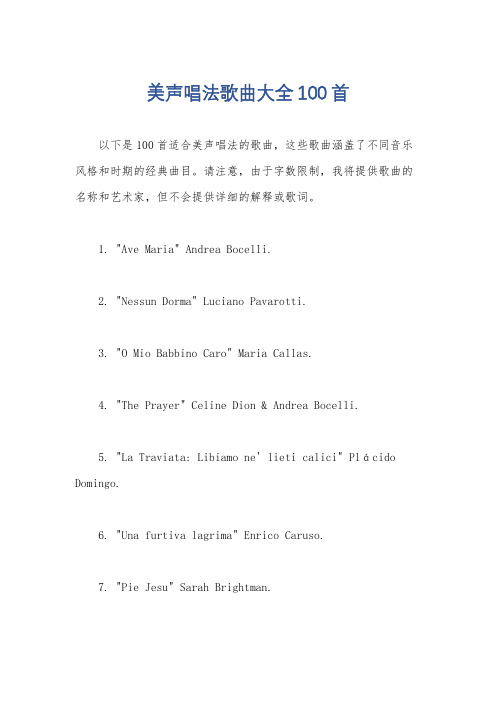
美声唱法歌曲大全100首以下是100首适合美声唱法的歌曲,这些歌曲涵盖了不同音乐风格和时期的经典曲目。
请注意,由于字数限制,我将提供歌曲的名称和艺术家,但不会提供详细的解释或歌词。
1. "Ave Maria" Andrea Bocelli.2. "Nessun Dorma" Luciano Pavarotti.3. "O Mio Babbino Caro" Maria Callas.4. "The Prayer" Celine Dion & Andrea Bocelli.5. "La Traviata: Libiamo ne' lieti calici" Plácido Domingo.6. "Una furtiva lagrima" Enrico Caruso.7. "Pie Jesu" Sarah Brightman.8. "Che gelida manina" Luciano Pavarotti.9. "Habanera" from Carmen Maria Callas.10. "O Sole Mio" Luciano Pavarotti.11. "Ombra mai fu" Andreas Scholl.12. "Der Hölle Rache" from The Magic Flute Diana Damrau.13. "Panis Angelicus" Josh Groban.14. "Nella Fantasia" Il Divo.15. "Lascia ch'io pianga" Katherine Jenkins.16. "Una voce poco fa" Joyce DiDonato.17. "Caro mio ben" Cecilia Bartoli.18. "Miserere" Gregorio Allegri.19. "Ombre mai fu" Cecilia Bartoli.20. "Voi che sapete" Frederica von Stade.21. "Dido's Lament" Jessye Norman.22. "Ave Maria" Luciano Pavarotti.23. "Ombra mai fu" Philippe Jaroussky.24. "Largo al factotum" Leo Nucci.25. "Che farò senza Euridice?" Janet Baker.26. "Laudate Dominum" Emma Kirkby.27. "L'amour est un oiseau rebelle" from Carmen Maria Callas.28. "Ombra mai fu" Rolando Villazón.29. "Hallelujah" Katherine Jenkins.30. "Vesti la giubba" Enrico Caruso.31. "Ebben? Ne andrò lontana" Maria Callas.32. "Porgi, am or" Renée Fleming.33. "Requiem: Pie Jesu" Charlotte Church.34. "Vissi d'arte" Maria Callas.35. "Lasciatemi morire" Montserrat Caballé。
英文歌We-are-the-world-歌曲

演唱人员
出场顺序,独唱部分: *Lionel Richie * Stevie Wonder * Paul Simon *Kenny Rogers * James Ingram * Tina Turner * Billy Joel * Michael Jackso * Diana Ross * Dionne Warwick * Willie Nelson * Al Jarreau * Bruce Springsteen * Kenny Loggins * Steve Perry * Daryl Hall * Michael Jackson * Huey Lewis * Cyndi Lauper * Kim Carnes * Bob Dylan
电影天才少女点评英语作文

The film Gifted is a heartwarming and thoughtprovoking drama that revolves around the life of a young girl named Mary,who is portrayed as a mathematical prodigy. Directed by Marc Webb,known for his work on The Amazing SpiderMan,this movie takes a deep dive into the complexities of nurturing a childs talent while also considering her emotional and social wellbeing.Plot Overview:The story follows Mary,who is under the care of her uncle Frank,after the loss of her mother,a brilliant mathematician who died under mysterious circumstances.Frank,a repairman by trade,is determined to give Mary a normal childhood,despite her extraordinary abilities.The narrative unfolds as Marys talent is recognized by her school teacher,Evelyn,who believes that Mary should be pushed to her full potential and enrolls her in a specialized school.Character Development:Mary,played by Mckenna Grace,is a delightful character who is both intelligent and innocent.Her interactions with her uncle Frank,portrayed by Chris Evans,showcase a deep bond that is central to the films emotional core.Franks struggle to balance Marys academic needs with her desire for a normal life is a key aspect of the movie.Cinematography and Visuals:The cinematography is simple yet effective,capturing the essence of the coastal town where the story is set.The visuals are not overly dramatic,allowing the audience to focus on the characters and their relationships.Performances:Chris Evans delivers a nuanced performance as Frank,showing a range of emotions from frustration to tenderness.His portrayal of a man torn between doing whats best for his niece and preserving her childhood is both believable and compelling.Jenny Slate,as Marys teacher,brings a sense of warmth and concern that adds depth to her character.Themes:The film explores themes of family,the burden of genius,and the struggle to find a balance between nurturing talent and allowing a child to have a normal life.It raises questions about the ethics of pushing a child to excel and the potential consequences of doing so.Soundtrack:The soundtrack complements the films emotional tone,providing a subtle backdrop to the story without overpowering the narrative.Cultural Impact:Gifted has resonated with audiences for its portrayal of a gifted childs struggles and the dilemmas faced by those who care for her.It has sparked discussions about the education of gifted children and the importance of considering their emotional needs alongside their intellectual development.Conclusion:Gifted is a poignant film that offers a fresh perspective on the challenges faced by exceptionally talented children and their families.It is a testament to the importance of love,understanding,and the pursuit of happiness,even in the face of extraordinary circumstances.The film is a mustwatch for anyone interested in the complexities of human relationships and the delicate balance between potential and personal fulfillment.。
PLA 85 说明书

50119511 G1 Valid from 2018 week 46PLA 85Pos. No. Varebetegnelse Description of goods WarenbezeichnungDésignation des pièces80690085 Plasmaslange med centraltilslutning, 6m Plasma torch with central adaptor plug, 6m Plasmaschlauch mit Zentralanschluss, 6m Torche plasma avec raccordement central, 6m 1 45050101 TastTrigger Taster Gâchette 2 71610194 Monteret print PCBPlatine Circuit imprimé montée 3 80600096 VippearmTipping device Kippvorrichtung Dispositif à bascule 4 80600092 Håndtag Handle HandgriffPoignée5 80600098 Skruer for håndtag (1 sæt = 5 stk)Screw for handle (1 set = 5 pcs) Schraube für Handgriff (1 Satz = 5 Stück) Vis pour poignée (1 jeu = 5 pièces) 6 80600097 Kontaktstift Contact pin Kontaktstift Fiche de contact 7 80650005 Brænderhoved Torch body Brennerkörper Corps de torche 7a 80600018 Gasrør Gas tube Gasrohr Tubeà gaz 8 80610005 Elektrode Electrode Elektrode Electrode9 80630009 Dyse 1,2 mm Nozzle 1.2 mm Düse 1,2 mm Buse 1,2 mm 9 80630010 Dyse 1,4 mm Nozzle 1.4 mm Düse 1,4 mmBuse 1,4 mm 10 80630011 Beskyttelseskappe Protective capSchutzkappe Bague de protection 11 80600088 Afstandsfjeder Distance spring AbstandsfederRessort de distance 12 80600101 Afstandsbøjle (2 ben)Distance ring (2 legs)Distanzbügel (2 Schenkel) Dispositif de distance (2 pied)12A 80600108 Afstandsbøjle Distance ringDistanzbügel Dispositif de distance 13 24510237 NøgleKey Universalschlüssel Clef14 82034014 GasflowmeterGas flowmeter GasdurchflußmesserDébitmètre de gaz15 80680085 Slangemodul PDX 85 m/ZA, 6mHose module PDX 85 with ZA, 6mSchlauchmodul PDX 85 with ZA, 6m Module de torche PDX 85 avec ZA, 6m 16 45070007 Slangeaflastning ø35 Hose protection ø35Schlauchentlastung ø35 Douille isolate de cable ø3517 40110406 CHJ skrue M4x6CHJ screw M4x6 Zylinderkopfschraube M4x6 Vis CHJ screw M4x618 25450047 Aflastningsring Relief-ringEntlastungsringBague d’allègement 19 80200335 Møtrik til ZA, plastik Nut for ZA, plasticMutter für ZA, Plastik Écrou pour ZA, plastique 20 80300601 Centraltilslutning Central adaptor plug ZentralsteckerFiche de contact 21 80300603 Hanstik kontaktdel Male contact partKontaktteil männlich Partie de contact, mâle 21a 80300602 Hanstik til ledningMale pin for wireKontaktteil für Leitung, männlich Connecteur mâle (câble)22 80600091 Cirkelslag kompletCircle cutting device completeKreisschneide-Einrichtung komplett Support pour coupe circulaire complet 22A 80600094 Stang for cirkelslagRadius arm for circle cutting device Führungsstang für Kreisschneide-Einrichtung Bras support pour coupe circulaire 22B 80600090 Brændervogn (drejebar) Torch carriage (revolving) Brennerwagen (drehbar) Support torche (pivotant)23 80600093 Brændervogn (fast) Torch carriage (fixed)Brennerwagen (fest)Support torche (fixe)。
律律的情书第七集-------纯の星

虎东:REAL ROMANCE情书SEASONⅡ!欢迎来到这个粉色的世界!只要你爱她就能成就爱情的传奇!掌声热烈欢迎大韩民国最优秀的男人!公开——(画外音:最强外貌SJ的封面模特——1号崔始源;电视剧主角回归的无能BOY——2号金基石;天籁的声音浪漫BOY——3号TEI;傻头傻脑的名言博士——4号金钟民;新时代的SUPER STAR SS501的LEADER——5号金贤重;妖娆的面容花美男代表——6号金希澈;高级代名词张英兰的某人——7号李成真!)成真(摆手摆手):不是“某人”啊,不是的。
虎东(无视无视):金基石电视剧拍得怎么样了?(成真郁闷)贤重:虎东哥,成真哥跟你说话呢~虎东:这个孩子……难道我就不是哥么?跟你还比成真要亲呢~我对你很好吧?贤重(无辜无辜):因为跟哥很熟的缘故……(字幕:只有跟亲密的人才敢提出建议?)虎东:今天我们这里来了很多花美男啊~始源XI、贤重XI……啊,还有我们比女嘉宾还要漂亮的辛德瑞拉公主希澈XI……三位觉得谁比较漂亮呢?10元(谦虚谦虚):我觉得希澈哥跟贤重哥都很帅啊……贤重:我觉得始源XI比较帅啊~(诚实诚实)希澈(打断):可是他觉得我比较帅呢~你也应该觉得我比较帅吧?(贤重神奇神奇)虎东(紧急整理):关于长相问题我们等等讨论啊,我们先欢迎今天的女嘉宾们,真的是很美丽的七位女嘉宾啊~欢迎,今天的女王们!(画外音:绝对美丽绝对撒娇——1号秀珍;世纪最可爱女生——2号黄宝拉;力量的象征才智少女——3号赵静林;即将在这个夏天结婚的MC——4号朴京林;人气绝顶性感魅惑——5号蔡妍;优雅恬静新时代的IDOL——6号姜晶花;负担百倍绝对没有非好感——7号张英兰!)虎东:这位今天不得不特别介绍一下啊~(京林高兴)张英兰!(京林倒,虎东笑)京林:我还以为是我呢~虎东:开个玩笑~京林真的是第一次来参加明星配对节目呢~(京林点头)马上也要结婚了啊,你家里的那位就不担心吗?京林:因为马上要结婚了,以后就不可以跟男明星搞罗曼史了啊,很感谢剧组这次邀请了很多花美男啊~(钟民暗自确定)虎东:可是在XMAN的罗曼史很失败呢~(京林不爽不爽)虎东:好,我们保持这个很美好的气氛继续进入第一个环节,爱称环节!第一位,秀珍!秀珍:可爱的小宝贝……请出来吧~(可爱可爱)始源、钟民:我确定是我的爱称!虎东:……祝贺始源!(钟民慌张)钟民:还有我啊!还有我!(虎东无视)虎东:赵静林!赵静林:今天……真的有很多中意的人,如果……可以都出来就好了……只属于我的BOY,请出来吧!(金基石、贤重出列,静林幸福)虎东:静林啊,这里有你的理想型在吗?静林:NE……虎东:是基石吗?你们上一次还成为了完美CP呢~静林(慌张):是很久以前的事情了!(基石倒塌)虎东(大笑):那就是贤重了啊?贤重:哦,谢谢。
na_english
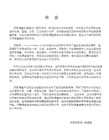
#Production Team
John Doyle
Steven Ferreira
Scott Murray
Mat Thomas
Michael Upton
Kristian von Fersen
Robert Wyle
#Design Team
Rod Chong
Marc De Vellis
Andrew Hulme
Curtis Meyers
Jason Marshall
Jameson Rafter
Frank Shin
#Localization
#Localization Producer
Christophe Labrune
Vincent Renaud
#Localization Coordination
Stefano Zanetti
Matthew Wan
Robin Martin Cases
Mike Richard
#Art Directors
Eduardo Agostini
Neil Eskuri
Nicholas Tay
#CG Supervisors
Clint Hanson
Jason Mullings
Stefan Oberg
Sean Payne
Jon Spencer
Darren Ward
Jingtao Zhang
#NIS/FMV
Stephen Friesen
Nenad Jankovic
Leah Vilhan
#Rendering
Arn Arndt
helen keller 海伦凯勒
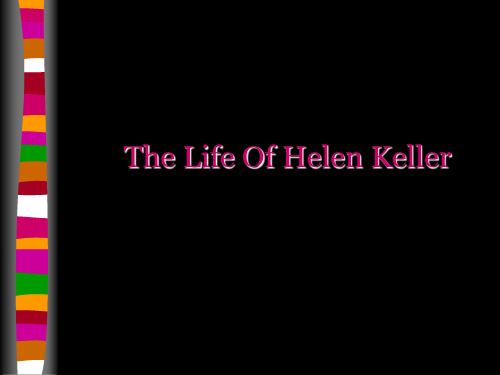
Starting To Make Sense
Anne took Helen down a path to a well-house井房 Someone was pumping water and Anne put Helen‟s hand under the water Anne immediately spelled out “water” over and over on Helen‟s hand Helen make the connection between the word “water” and the flowing liquid
Enough is Enough适可而止: A Timeline时间表 of Events
Kate Keller reads a Charles Dickens’ book called “American Notes.” It discussed work that had been done with another deaf and blind child. Mrs. Keller traveled to Baltimore to see a specialist for advice. The doctor told Mrs. Keller not to give up hope. He believed that Helen could be taught. He advised Mrs. Keller to visit a local expert on the problems of deaf children. This expert, Alexander Graham Bell, was now concentrating on his true vocation: the teaching of deaf children.
第1章 电子商务概述 《电子商务与网络经济》PPT课件

3)资金流
定义:买方如何把货币支付给卖方
如何防范逃避关税的行为
1.6.2 从物流的角度来划分电子商务
在线交易 离线交易 半在线半离线交易
1.6.3 不同的电子商务方式的不同影响
以关税征收为例 在线交易对关税征收的影响 许可贸易方式设计在线交易
基于互联网
1.1.5 电子商务的基本特征
利用现代计算机技术和互联网技术 传统的商务活动发生了巨大变化,新生
事物不断涌现 不仅贯穿于商务和经济活动的全过程,
而且贯穿整个社会活动的始终
1.2 电子商务的发展历史
1.2.1 ARPA网络阶段(1968-1986年):研究 及试用阶段
1.2.2 NFSnet阶段(1986-1995年):科研应 用阶段
1.4.1企业对消费者的电子商务(B2C)
在线销售活动 比较成熟,最为熟悉
1.4.2企业对企业的电子商务(B2B)
电子商务的主要应用领域,企业间 以EDI为例
1.4.3企业对行政机构的电子商务 (B2G)
企业与政府机构间
如招标、采购、行政事务管理等
1.4.4消费者对行政机构的电子商务 (C2G)
1.1.3 企业的定义
HP公司 Intel公司 IBM公司
1)HP公司
售前服务到售后服务实现电子化、自动化
2)Intel公司
随时、随地、随意
3)IBM公司
采用数字电子方式进行商务数据交换和 开展商务业务
1.1.4 定义的比较分析
电子商务是商务活动还是贸易活动 电子商务是基于一切电子手段还是主要
1.6.1信息流、物流和资金流分析
1.6.2从物流的角度来划分电子商务
1.6.3不同的电子商务方式的不同影响
waterresearch编辑联系

WATER RESEARCH A Journal of the International Water AssociationEditor-in-ChiefMogens HenzeInstitute of Environment & Resources Technical University of Denmark BygningstorvetDK-2800 KGS LyngbyDenmarkTel: 45 4525 1477Fax: 45 4593 2850E-mail:**********.dkEditorsJ. BlockUniversité H. Poincaré, Nancy IFranceDavid DixonUniversity of MelbourneAustraliaHiroaki FurumaiThe University of TokyoJapanEberhard MorgenrothUniversity of Illinois Urbana-Champaign USAW. RauchUniversity InnsbruckAustriaMaria ReisUniversidade Nova de Lisboa/FCTPortugalHang-Shik ShinKorea Advanced Institute of Scienceand TechnologyKoreaMark van LoosdrechtDelft University of TechnologyThe NetherlandsThomas TernesBundesanstalt für Gewässerkunde GermanyStefan WuertzUniv. of California, DavisUSAHanqing YuUniversity of Science & Technology of China ChinaAssociate EditorsAndrew BakerThe University of BirminghamUK Damien BatstoneThe University of QueenslandAustraliaG-H. ChenThe Hong Kong University of Science& TechnologyHong KongChinaTom CurtisUniv. of Newcastle upon TyneUKAna DeleticMonash UniversityUSAFrancis de los Reyes IIINorth Carolina State UniversityUSARob EldridgeThe University of MelbourneAustraliaRosina GironesUniversity of BarcelonaSpainStephen GrayVictoria UniversityAustraliaKate GrudpanChiang Mai UniversityThailandXiaodi HaoBeijing University of Civil Engineeringand ArchitectureChinaE.E. HerricksUniversity of Illinois - UrbanaUSAH-Y. HuTsinghua UniversityChinaP.M. HuckUniversity of WaterlooCanadaBruce JeffersonCranfi eld UniversityUKSergey KalyuzhnyiMoscow State UniversityRussian FederationJaehong KimGeorgia Institute of TechnologyUSAGregory KorshinUniversity of WashingtonUSAJes La Cour JansenLund Institute of TechnologySwedenG. LangergraberBOKU/Univ. of Natural Res. andApplied Life Scs.AustriaAnna LedinTechnical University of DenmarkDenmarkS-L. LoNational Taiwan UniversityTaiwanY. MatsuiHokkaido UniversityJapanMax MaurerEAWAGSwitzerlandHow Yong NgNational University of SingaporeSingaporeSatoshi OkabeHokkaido UniversityJapanS.L. OngNational University of SingaporeSingaporeJong M. ParkPohang University of Science & TechnologyKoreaMiguel SalgotUniversity of BarcelonaSpainDavid SedlakUniversity of California, BerkeleyUSAJean-Philippe SteyerLBE-INRAFranceM. TakahashiHokkaido UniversityJapanKai UdertEAWAGSwitzerlandV.P. VenugopalanBARC FacilitiesIndiaE. von SperlingFederal University of Minas GeraisBrazilA.I. ZouboulisAristotle UniversityGreeceEditorial Offi ceMailing addressWater ResearchRadarweg 291043 NX AmsterdamThe NetherlandsTel: 31 20 485 2701Fax: 31 20 485 2521; 31 20 485 3264E-mail:******************Publication information: Water Research (ISSN 0043-1354). For 2010, volume 44 is scheduled for publication. Subscription prices are available upon r equest from the publisher or from the Elsevier Customer Service Department nearest you or from this journal’s website (/locate/watres). Further informa-tion is available on this journal and other Elsevier products through Elsevier’s website (). Subscriptions are accepted on a prepaid basis only and are entered on a calendar year basis. Issues are sent by standard mail (surface within Europe, air delivery outside Europe). Priority rates are available upon request. Claims for missing issues should be made within six months of the date of dispatch.Author Enquiries: Please visit this journal’s homepage at /locate/watres. You can track accepted articles at / trackarticle and set up e-mail alerts to inform you of when an article’s status has changed. Also accessible from here is information on copyright, frequently asked questions and more. Contact details for questions arising after acceptance of an article, especially those relating to proofs, will be provided by the publisher. Orders, claims, and journal enquiries: Please contact the Elsevier Customer Service Department nearest you:St. Louis: Elsevier Customer Service Department, 11830 Westline Industrial Drive, St. Louis, MO 63146, USA; phone: (877) 8397126 [toll free within the USA]; (+1)(314)4537076[outsidetheUSA];fax:(+1)(314)5235153;e-mail:***************************************Oxford: Elsevier Customer Service Department, The Boulevard, Langford Lane, Kidlington OX5 1GB, UK; phone: (+44) (1865) 843434; fax: (+44) (1865) 843970;e-mail:****************************************Tokyo: Elsevier Customer Service Department, 4F Higashi-Azabu, 1-Chome Bldg, 1-9-15 Higashi-Azabu, Minato-ku, Tokyo 106-0044, Japan; phone: (+81) (3) 55615037;fax:(+81)(3)55615047;e-mail:*****************************************Singapore: Elsevier Customer Service Department, 3 Killiney Road, #08-01 Winsland House I, Singapore 239519; phone: (+65) 63490222; fax: (+65) 67331510; e-mail:****************************************Application for membership of Internatio nal Water Asso ciatio n should be made to: Executive Director, IWA, Alliance H ouse, 12 Caxton Street, London SW1H 0QS, U.K. (Tel.: +44 207 654 5500; Fax: +44 207 654 5555; e-mail:*****************.uk;website: ). Registered Charity (England) No. 289269. Individual membership is available from £30 upwards.For details contact IWA.。
魏珏的推荐
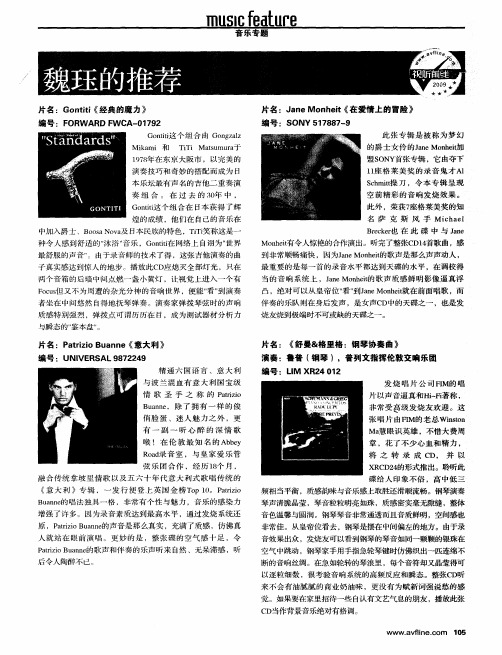
碟给 人 印 象不 俗 ,高 中 低三 频 相当平衡 ,质感韵味 与音乐感 上取胜 还滑顺流畅 。钢琴演奏 琴 声清脆晶莹 ,琴音粒粒 明亮如珠 ,质感密实毫无隙缝 ,整体 音色温馨与圆润 。钢琴琴 音非常 通透而且音质鲜明 ,空间感也
增强 了许多 。因为录 音素 质达 到最高 水平 ,通过发 烧 系统 还
最舒服 的声音 ” 。由于录 音师 的技 术了得 ,这张吉他演 奏的 曲 子真实感 达到惊 人的地步 。播 放此c D应熄灭 全部灯 光 ,只在 两个 音箱 的后墙 中间点燃 一盏 小黄灯 ,让视 觉 上进入一 个有
Mo hi 令人 惊艳的合作演 出。听完了整张c 4 n et 有 Dl 首歌曲 ,感
到非常 顺畅痛快 ,因为Jn net aeMo hi 的歌声是 那么声声动 人 ,
最重要 的是 每一首 的录 音水平 都达 到天碟 的水平 ,在调校 得 当 的音 响 系统 上 ,Jn n e 的 歌 声 质感 鲜 明影 像逼 真 浮 aeMo h i t 凸,绝 对可 以从皇 帝位 ” ” aeMo h i 看 NJn n e 就在前 面唱歌 ,而 t 伴 奏 的乐队则在 身后发声 ,是女声C D中的 天碟 之一 ,也 是发 烧 友烧到极端时不可或缺 的天碟之一 。
编 号 :S Y 5 7 8 — ON 1 8 7 9 此 张 专辑 是 被 称 为 梦 幻
的爵 士女 伶 的Jn n e  ̄ aeMo h iJ tⅡ
1 7 年在 东京 大阪市 ,以完美 的 98 演奏技 巧和奇 妙的搭 配而 成为 日 本 乐坛最 有声 名的 吉他二 重奏演
编 号 :UN VE S L9 7 2 9 l R A 8 2 4
精 通 六 国语 言 、意 大 利 与 波 兰 混血 有 意 大 利 国 宝级 情 歌 圣 手 之 称 的 P tzo ar i i B a n ,除 了 拥 有 一 样 的俊 un e 俏脸 蛋 、迷 人 魅 力 之 外 ,更
英国女歌手唱月亮海的英文歌曲
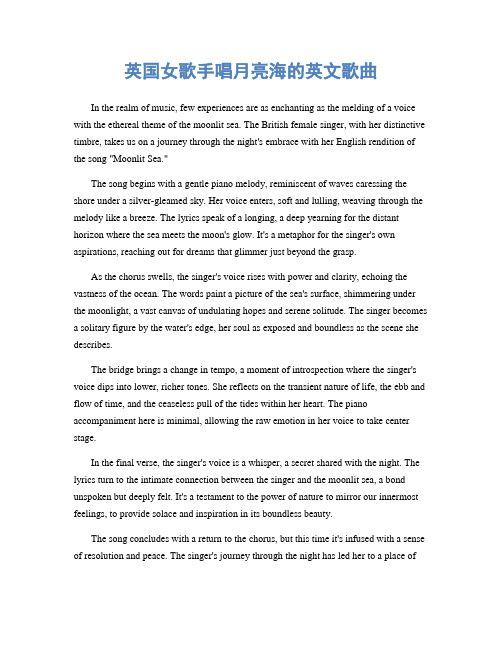
英国女歌手唱月亮海的英文歌曲In the realm of music, few experiences are as enchanting as the melding of a voice with the ethereal theme of the moonlit sea. The British female singer, with her distinctive timbre, takes us on a journey through the night's embrace with her English rendition of the song "Moonlit Sea."The song begins with a gentle piano melody, reminiscent of waves caressing the shore under a silver-gleamed sky. Her voice enters, soft and lulling, weaving through the melody like a breeze. The lyrics speak of a longing, a deep yearning for the distant horizon where the sea meets the moon's glow. It's a metaphor for the singer's own aspirations, reaching out for dreams that glimmer just beyond the grasp.As the chorus swells, the singer's voice rises with power and clarity, echoing the vastness of the ocean. The words paint a picture of the sea's surface, shimmering under the moonlight, a vast canvas of undulating hopes and serene solitude. The singer becomes a solitary figure by the water's edge, her soul as exposed and boundless as the scene she describes.The bridge brings a change in tempo, a moment of introspection where the singer's voice dips into lower, richer tones. She reflects on the transient nature of life, the ebb and flow of time, and the ceaseless pull of the tides within her heart. The piano accompaniment here is minimal, allowing the raw emotion in her voice to take center stage.In the final verse, the singer's voice is a whisper, a secret shared with the night. The lyrics turn to the intimate connection between the singer and the moonlit sea, a bond unspoken but deeply felt. It's a testament to the power of nature to mirror our innermost feelings, to provide solace and inspiration in its boundless beauty.The song concludes with a return to the chorus, but this time it's infused with a sense of resolution and peace. The singer's journey through the night has led her to a place ofacceptance, an understanding that while some dreams may remain distant, the pursuit itself is a source of profound joy and fulfillment."Moonlit Sea" is more than a song; it's an experience, a narrative set to music that captures the essence of the human spirit's connection to the natural world. The British singer's rendition is a masterful blend of lyrical storytelling and vocal artistry, leaving listeners with a lingering sense of wonder and an urge to find their own moonlit sea.Through her performance, the singer invites us to look beyond the mundane, to find beauty in the quiet moments, and to feel the pull of the unknown. It's a reminder that music, at its best, can transport us to places within ourselves that we never knew existed, and to emotions as deep and vast as the sea itself. The song "Moonlit Sea," as sung by this talented British artist, is a testament to the enduring power of song to move, to inspire, and to connect us all under the canopy of the night sky. 。
Starter Unit 1 Hello!课件(共18张PPT,内嵌音频)

Personal Computer
ATM
Automatic Teller Machine
1b
Listen, write down theபைடு நூலகம்sentences and repeat.
Conversation 1 Bob: Good morning, Helen! Helen: Hi, Bob! Conversation 2 Cindy: Good morning, Alice! Alice: Good morning, Cindy! Conversation 3 Dale: Hello, Frank! Hello, Eric! Frank/Eric: Good morning, Dale!
Alice ['ælɪs]
Mr. Crisp
Miss Williams
Mr. May
Jim ClarkBetty ClarkSue ClarkSandy Clark
English names
Chinese: 姓+名English: 名+姓Title称谓: Mr. / Ms. / Miss / Mrs.姓:family name / last name 名:given name / first name全名: First name + last name (given name + family name)
Meet with friends!
Exercises
单项选择题。1. -Good morning, Jane. -____, Joe. A. Good morning B. Good afternoon C. Good evening2. -How are you? -____ A. I’m Ben. B. How are you? C. I’m fine, thanks.3. 下列字母与字母C含有相同音素的是____ A. BDF B. DGE C. BEH
德国流行天后海琳娜的音乐天赋
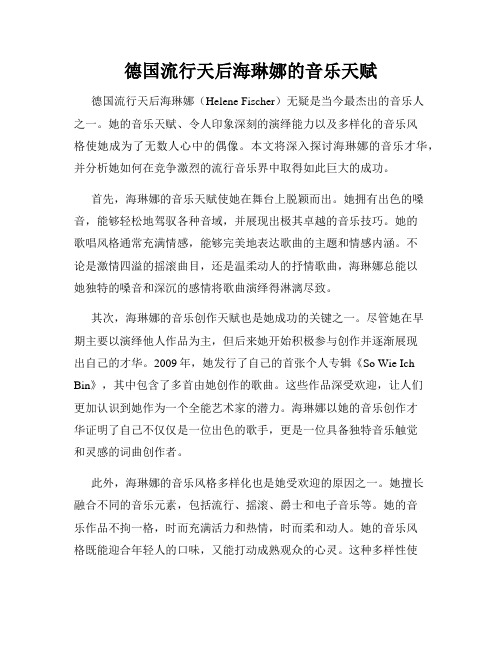
德国流行天后海琳娜的音乐天赋德国流行天后海琳娜(Helene Fischer)无疑是当今最杰出的音乐人之一。
她的音乐天赋、令人印象深刻的演绎能力以及多样化的音乐风格使她成为了无数人心中的偶像。
本文将深入探讨海琳娜的音乐才华,并分析她如何在竞争激烈的流行音乐界中取得如此巨大的成功。
首先,海琳娜的音乐天赋使她在舞台上脱颖而出。
她拥有出色的嗓音,能够轻松地驾驭各种音域,并展现出极其卓越的音乐技巧。
她的歌唱风格通常充满情感,能够完美地表达歌曲的主题和情感内涵。
不论是激情四溢的摇滚曲目,还是温柔动人的抒情歌曲,海琳娜总能以她独特的嗓音和深沉的感情将歌曲演绎得淋漓尽致。
其次,海琳娜的音乐创作天赋也是她成功的关键之一。
尽管她在早期主要以演绎他人作品为主,但后来她开始积极参与创作并逐渐展现出自己的才华。
2009年,她发行了自己的首张个人专辑《So Wie Ich Bin》,其中包含了多首由她创作的歌曲。
这些作品深受欢迎,让人们更加认识到她作为一个全能艺术家的潜力。
海琳娜以她的音乐创作才华证明了自己不仅仅是一位出色的歌手,更是一位具备独特音乐触觉和灵感的词曲创作者。
此外,海琳娜的音乐风格多样化也是她受欢迎的原因之一。
她擅长融合不同的音乐元素,包括流行、摇滚、爵士和电子音乐等。
她的音乐作品不拘一格,时而充满活力和热情,时而柔和动人。
她的音乐风格既能迎合年轻人的口味,又能打动成熟观众的心灵。
这种多样性使得海琳娜的音乐能够触及更广泛的群体,成为了她登上音乐榜单和赢得众多奖项的理由之一。
最后,海琳娜在舞台表演方面的天赋也功不可没。
她的舞台演出总是精彩纷呈,充满能量和魅力。
她擅长与观众建立紧密的联系,能够将音乐表达和舞台动作完美地结合在一起。
她的表演风格充满活力,充满了她对音乐的热爱和投入。
无论是大型演唱会还是电视节目,海琳娜总能以她过人的表演才华和亲和力将观众带入她的音乐世界。
总结而言,海琳娜以她的音乐天赋、音乐创作才华、多样化的音乐风格以及精彩纷呈的舞台表演成就了她作为德国流行天后的地位。
爱乐活攻略267138
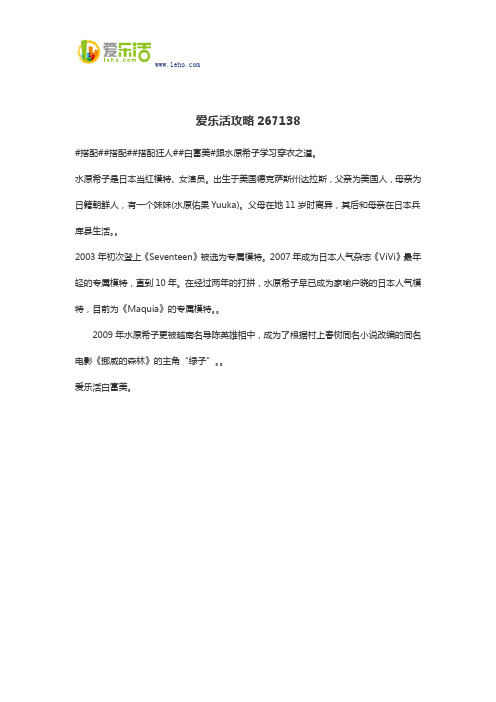
爱乐活攻略267138
#搭配##搭配##搭配狂人##白富美#跟水原希子学习穿衣之道。
水原希子是日本当红模特、女演员。
出生于美国德克萨斯州达拉斯,父亲为美国人,母亲为日籍朝鲜人,有一个妹妹(水原佑果Yuuka)。
父母在她11岁时离异,其后和母亲在日本兵库县生活。
2003年初次登上《Seventeen》被选为专属模特。
2007年成为日本人气杂志《ViVi》最年轻的专属模特,直到10年。
在经过两年的打拼,水原希子早已成为家喻户晓的日本人气模特,目前为《Maquia》的专属模特。
2009年水原希子更被越南名导陈英雄相中,成为了根据村上春树同名小说改编的同名电影《挪威的森林》的主角“绿子”。
爱乐活白富美。
爱乐活——有态度、正能量的品质生活社区。
热爱生活,乐于分享的各类达人聚在这里,分享消费攻略,激发生活灵感,发现城市最IN 的角落。
在这里,有爱,有乐,有生活。
【更多精彩内容尽在爱乐活】
文章来源:/post/2ff7a77f6453bf36c4e918e0?from=wenku/?from=wenku。
关诗敏

关诗敏活动照(7张)2012年8月17日,参加台湾娱乐节目《康熙来了》,作为最后一位出场选手,演唱了张惠 妹的《记得》;同年8月24日,推出首张个人音乐专辑《关在家》,收录了包括《半个地球的挂念》、《喜欢不 喜欢》、《快递甜心》等在内的11首歌曲 ;同年9月,举办出道首场签唱会 ;同年9月14日,在北京举行首 张个人专辑《关在家》的发片会,并现场演唱了专辑中的《快递甜心》、《魔法爱情》2首歌曲,以及二胡版的 《最炫民族风》和二胡曲目《赛马》 ;同年11月2日,举办“关在家HomeParty轰趴”个人小型音乐派对 。
人物评价
关诗敏长相清纯可爱,而且歌声甜美(21CN评) 。关诗敏唱《千言万语》宛如小邓丽君(刘家昌评) 。 关诗敏年纪轻轻唱功过人,她以后会是蔡依林(吴克群评) 。
歌曲《天气预报》在清新畅快的木吉他伴奏中,让关诗敏轻松自然地展现歌声中真实而甜美的魅力(新华网 评) 。
关诗敏人物评价
感谢观看
关诗敏
美籍华裔女歌手
01 早年经历
03 人物评价
目录
02 演艺经历
关诗敏(Sharon Kwan),1995年10月12日出生于美国,美籍华裔女歌手,毕业于美国网络高中。
2011年,参加台湾电视选秀节目《华人星光大道》的比赛,并最终获得总决赛冠军 。2012年,推出首张个 人音乐专辑《关在家》 。2013年1月,获得“蒙牛绿色心情中国TOP排行榜”港台最受欢迎新人提名;同年,出 演个人首部电视剧《飞越龙门客栈》 。2014年,参加江苏卫视《花样年华第二季》节目 。2015年,参加浙江卫 视《中国好声音第四季》的比赛,获得周杰伦组四强、全国16强 。2016年,推出第二张个人音乐专辑《绽放 2.0》 。
- 1、下载文档前请自行甄别文档内容的完整性,平台不提供额外的编辑、内容补充、找答案等附加服务。
- 2、"仅部分预览"的文档,不可在线预览部分如存在完整性等问题,可反馈申请退款(可完整预览的文档不适用该条件!)。
- 3、如文档侵犯您的权益,请联系客服反馈,我们会尽快为您处理(人工客服工作时间:9:00-18:30)。
PROFILE:Information architecture professional with over 9 years of experience working with Internet technologies.Strong background and skills in usability, needs assessment, prototyping, user interface design, anddevelopment. Master’s candidate in Information Management with a concentration in Human-ComputerInteraction. Seeking positions in Information Architecture, User Experience and/or Interaction Design. EDUCATION:University of California at Berkeley, Berkeley, CA May 2006 (expected) •Master of Information Management & Systems•Selected Coursework: Needs & Usability Assessment, User Interface Design & Development, Information Organization & Retrieval, XML & Related TechnologiesBarnard College, Columbia University, New York, NY May 1995•Bachelor of Arts in Anthropology (minor in Biology)•Thesis: “How Canadian Multicultural Policy Has Affected Ethnic Identity” (research included conducting ethnographic interviews)PROFESSIONAL EXPERIENCE:Database Usability Consultant, Institute of International Studies, UC Berkeley Jan 2006-present •Design and conduct user interviews and testing to pinpoint user problems with database interface.•Analyze findings, make design recommendations, and implement redesign.•Find and fix bugs in the PHP and mySQL code for final deployment of application.Mobile Shopper Mobile Prototype Workshop January 2006 •Worked with a small team of developers to design and implement a shopping application for the mobile phone using Python for Symbian OS and PHP for a week-long workshop.•Presented prototype to peers and Yahoo! Research team.Graduate Student Instructor, School of Information Management, UC Berkeley Sept-Dec 2005 •Prepared and led discussion sessions on various technical, social and economic topics dealing with search engine technologies. [course info]•Gave advice and graded assignments and projects for a class of around 100 students.HCI Researcher, SAP Research, Palo Alto, CA Jun-Aug 2005 •Conducted and produced a literature survey that investigated methods of mapping content to user and device-specific interfaces for the proactive user interface project.•Built a prototype to illustrate content mapping based on user profiles, pipelines and XSLT.•Identified a model-based mapping framework and presented findings to peers and other departments. Webmaster, Center for Social Services Research, UC Berkeley Jul 2001-May 2005•Restructured the CSSR website [homepage]to improve consistency, logic, and usability based on information architecture principles.•Completely rebuilt a small static HTML website into a large, complex, dynamic website with ASP server-side programming.•Originated a file-naming convention to organize and access data logically and consistently.•Established an extensive QA tracking system working with QA team to catch errors.•Added a searchable publications database with computer/PDA-accessible PDF downloads.•Using SAS-generated XML, generated printer-friendly/web-friendly pages using XSL.•Optimized search engine rankings with registration, meta-tags, and link-trades with related websites. Analyzed server logs.•Hired, trained, managed assistants to help update the website. Created training documentation.Web Developer, Terra Lycos, Inc., San Francisco, CA Apr 2000-May 2001•Successfully delivered multiple "Artist Special Feature" pages for Lycos Music's largest client, (1M+ page views per feature). These top priority projects were highly time-sensitive andpromoted throughout the network. [Lycos Music][Hotbot]•Hand-coded web pages using DHTML and ASP (in VBScript) according to design specifications.•Worked with Product Managers, Designers, and QA to ensure timeliness and quality of projects.Webmaster/ Communications Associate, International Center in NY, New York, NY Jan 1997-Feb 2000•Supervised development, redesigned layout, edited, formatted, promoted new website [homepage] and newsletter to recruit potential volunteers and international students.•Conducted monthly internet and e-mail workshops for members and volunteers.•Devised complex SQL queries, reports using dbase IV, Access databases for targeted mailings. Marketing Assistant / Tracking Coordinator, , New York, NY Sept-Dec 1996 •Tracked cost-per-1000-impressions (CPM) for online ads to ensure contractual compliance.•Developed documentation & trained co-workers on ad-serving NetGravity software.SCHOOL PROJECTS:Participated in needs assessment, requirements gathering, user interviews, design, development, prototyping, implementation and/or documentation in a number of class projects.Social Responsibility Barcode Project[final project documentation]Fall 2005-present Consumer application that scans product ID to return social and environmental manufacturing data. Proof-of-concept prototype developed for Flash lite plug-in and Symbian OS on the mobile phone.UFOVis [project website]Fall 2005Visualization of UFO sighting data incorporating the Yahoo! Maps API.Collaborative Bargains Database Application Fall 2005Shopping deals aggregator and search application developed using PHP and mySQL database.SIMster Peer-to-Peer Network Application Spring 2005Distributed computing application that searches for, connects, and exchanges data with peer nodes on the network.application Spring 2005 prototypeFilterFeederRSS feeds application that filters out/for subject keywords developed with smallx pipeline technology and XSL.Mobile Phone Art Tour Application [project website]Fall 2004Faceted metadata classification framework for a mobile public art tour application using Protégé ontology editor. SKILLS:Software: Dreamweaver, FrontPage, EditPlus; Visual InterDev, Eclipse, Perforce, NetBeans, Smallx Pipeline Technology, Ant; ImageReady, Photoshop, Media Cleaner Pro, Real Video plug-in technology, Macromedia Flash 8, Flash Lite, Aldus PageMaker (Mac and PC), Visio; SPSS, Access, Dbase IV, ACT, MySQL and Oracle databases; WS-FTP, Cross-browser compatibilities.Programming Languages: ASP (in VBScript), PHP, Python (Symbian OS), Java (working knowledge), JavaScript, CSS, DHTML, AJAX, HTML (hand-coder), XML, XSL, and SQL.Other: Korean, French. Excellent written and verbal communication skills. Demonstrated team player. Thrives in collaborative environments.。
